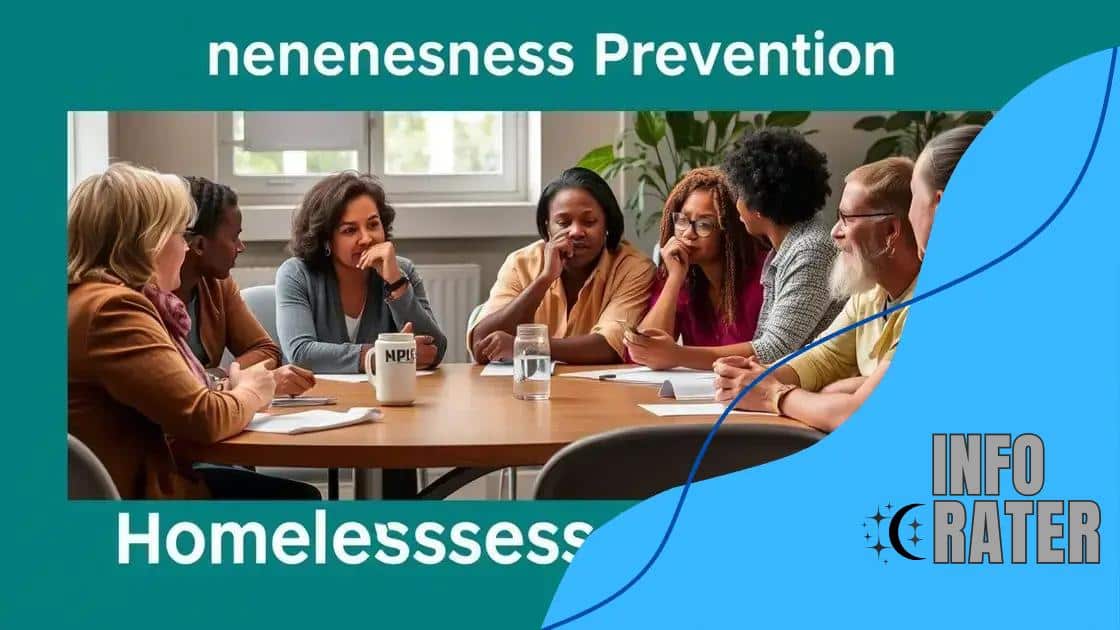Homelessness prevention initiatives across cities

Homelessness prevention initiatives across cities involve strategies like housing-first models and community engagement to reduce homelessness by providing support services, training programs, and fostering collaboration among local organizations.
Homelessness prevention initiatives across cities play a crucial role in addressing the ongoing crisis that affects many urban areas. Have you ever wondered how different cities tackle this pressing issue? In this article, we’ll dive into effective strategies and programs designed to help those at risk of homelessness.
Understanding the causes of homelessness
Understanding the causes of homelessness is key to developing effective prevention initiatives. Many factors contribute to this complex issue, including economic, social, and personal circumstances.
One primary cause is economic instability. Many individuals face challenges in securing stable employment, which can lead to an inability to pay rent or buy basic necessities. Additionally, rising housing costs in urban areas create a barrier for low-income families.
Social Factors
Social factors also play a significant role in homelessness. Issues such as domestic violence, family breakdowns, and substance abuse can lead individuals to lose their homes. Support systems are crucial in helping those at risk.
Key Causes of Homelessness
- Job loss or underemployment
- High housing costs compared to income
- Health issues, including mental health and addiction
- Lack of affordable housing options
Furthermore, mental health issues and untreated medical conditions can significantly affect an individual’s ability to maintain housing. Access to healthcare and support services plays a vital role in preventing homelessness.
As we examine the root causes, it becomes clear that a multifaceted approach is necessary. Initiatives must address not only immediate needs but also the underlying issues that lead to housing instability. Understanding these causes is essential for cities to implement meaningful homelessness prevention initiatives.
Key initiatives in major cities
Many cities have implemented effective initiatives to combat homelessness. These programs aim to provide support and resources to individuals at risk of losing their homes.
For instance, cities have recognized the importance of housing-first policies. This approach prioritizes placing individuals in stable housing before addressing other issues like job training or health care. By providing a permanent address, people are better able to regain stability in their lives.
Preventive Services
Another essential initiative includes preventive services aimed at keeping people in their homes. This may involve financial assistance for rent, deposit support, or legal aid to face eviction. Such services are crucial in preventing homelessness before it starts.
Collaboration with Nonprofits
Many cities collaborate with nonprofit organizations to enhance their efforts. These partnerships allow for greater resource pooling, creating comprehensive programs that cover various needs. Nonprofits often provide case management, counseling, and rehabilitation services that are vital for sustained recovery.
- Outreach programs that connect with the homeless directly.
- Job training initiatives to help individuals re-enter the workforce.
- Health services to address physical and mental health needs.
- Community engagement to raise awareness and support local efforts.
Moreover, cities are investing in community resources such as shelters and support centers. These facilities often serve as safe havens where individuals can access necessities while receiving guidance on moving forward. With these key initiatives, cities aim to create an environment where homelessness can be significantly reduced.
Successful case studies in prevention

There are several successful case studies that highlight effective strategies in preventing homelessness. These examples demonstrate how targeted initiatives can create lasting change in communities.
For instance, the city of Utah implemented a housing-first model, which significantly reduced chronic homelessness. By prioritizing stable housing, the program has helped thousands of individuals transition from shelters into permanent homes. This approach not only provides safety but also fosters independence and self-sufficiency.
Collaborative Efforts in Cities
In San Antonio, a coalition of local nonprofits and government agencies launched a program called Project Quest. This initiative focuses on job training and education, leading to improved employment rates among vulnerable populations. By empowering individuals with the skills needed for sustainable jobs, the program addresses one root cause of homelessness.
Community-Based Solutions
Another notable case is in New York City, where the HomeBase program offers preventive services for families at risk of eviction. This initiative provides financial assistance and legal support, which has proven effective in reducing the number of families entering the shelter system.
- 100% success rate in keeping families in their homes who participate in HomeBase.
- Reduction in annual costs associated with emergency housing services.
- Improvement in family stability as they maintain housing.
These examples underscore the importance of tailored initiatives that address the unique needs of each community. Successful case studies show that collaboration and innovation can lead to effective homelessness prevention strategies that benefit both individuals and society.
Community involvement in initiatives
Community involvement is crucial for the success of homelessness prevention initiatives. When local residents actively participate, programs can be more effective and responsive to the needs of those at risk.
For example, many cities have established volunteer programs that allow community members to engage directly with vulnerable populations. Volunteers provide support through various activities, including meal services, mentorship, and tutoring programs.
Building Awareness and Support
Engaging the community helps build awareness about homelessness. When people understand the challenges faced by those without stable housing, they are more likely to make a difference. Local events, such as awareness walks and fundraisers, encourage residents to contribute time and resources.
Collaborative Projects
Community members can also participate in collaborative projects that address homelessness. Initiatives like building tiny homes or renovating shelters foster a sense of ownership and pride. Such projects unite people from different backgrounds, promoting empathy and understanding.
- Organizing donation drives to collect essential items such as clothing and toiletries.
- Creating educational workshops to teach life skills and job readiness.
- Host neighborhood meetings to discuss local issues and potential solutions.
- Mentoring programs that match volunteers with at-risk individuals.
By encouraging community involvement, cities can create a supportive network for those affected by homelessness. Active participation nurtures a sense of responsibility and partnership, which is essential in implementing effective prevention initiatives.
Challenges faced by programs
Homelessness prevention programs face several challenges that can hinder their effectiveness. Understanding these obstacles is crucial for improving initiatives and achieving desired outcomes.
One significant challenge is the lack of funding. Many programs rely on grants and donations, which can fluctuate. Insufficient resources may limit the services they can provide, such as housing assistance or counseling. When budgets are tight, essential programs may be scaled back, affecting vulnerable populations.
Stigma and Misunderstanding
Another challenge is the stigma surrounding homelessness. Many people have misconceptions about those who experience homelessness. This stigma often leads to reduced community support for prevention initiatives. Education and awareness campaigns are crucial in changing perceptions and encouraging involvement.
Coordination Among Services
Furthermore, coordination among different organizations can be difficult. Many programs operate in silos, leading to gaps in services. Creating a unified approach is essential so that individuals can receive comprehensive support, including job training, housing assistance, and health care.
- Inconsistent policies across different regions can create confusion.
- Limited access to mental health and substance abuse resources can affect recovery.
- Restrictive eligibility criteria may exclude some individuals from receiving help.
Additionally, the changing economic landscape can complicate efforts. Economic downturns can increase the number of people at risk of homelessness, putting more strain on already limited resources. Addressing these challenges requires ongoing collaboration and innovation to enhance the impact of prevention programs.
In conclusion, preventing homelessness is a complex challenge that requires a committed effort from communities, organizations, and local governments. By understanding the causes and implementing effective initiatives, cities can make significant progress. Success often hinges on community involvement, collaboration among various services, and addressing the unique needs of vulnerable populations. As we continue to learn from successful case studies, it becomes clear that consistent support and innovation are key to creating lasting change. Together, we can work towards a future where everyone has a safe place to call home.
FAQ – Frequently Asked Questions about Homelessness Prevention Initiatives
What are homelessness prevention initiatives?
Homelessness prevention initiatives are programs and strategies designed to help individuals and families at risk of losing their homes, providing support services like housing assistance, job training, and more.
How can communities get involved in prevention efforts?
Communities can participate by volunteering, raising awareness, organizing donation drives, and engaging in local programs that support individuals facing homelessness.
What challenges do homelessness prevention programs face?
Key challenges include lack of funding, stigma surrounding homelessness, coordination among services, and ensuring consistent community support.
Can successful case studies help improve existing programs?
Yes, learning from successful case studies allows organizations to adopt effective strategies and tailor their approaches to better meet the needs of their communities.





